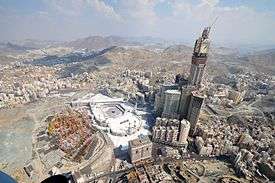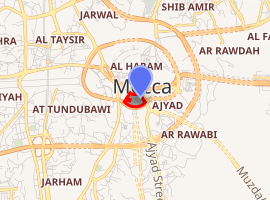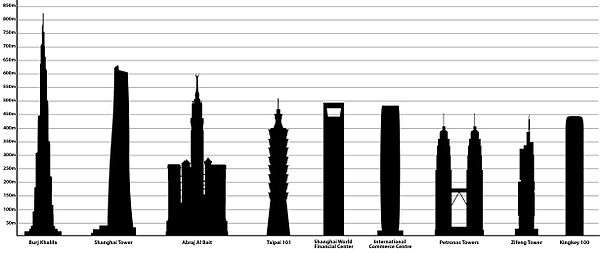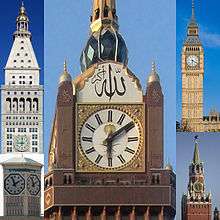Abraj Al Bait
The Abraj Al-Bait (Arabic: أبراج البيت "Towers of the House") is a government-owned complex of seven skyscraper hotels in Mecca, Saudi Arabia. These towers are a part of the King Abdulaziz Endowment Project that aims to modernize the city in catering to its pilgrims. The central hotel tower, the Makkah Royal Clock Tower, has the world's largest clock face and is the third-tallest building and fifth-tallest freestanding structure in the world. The clock tower contains the Clock Tower Museum that occupies the top four floors of the tower.[5]
| Abraj-Al-Bait | |
|---|---|
أبراج البيت | |
 Abraj Al Bait overlooking the Great Mosque of Mecca | |

| |
| General information | |
| Status | Complete |
| Type | Mixed use: Hotel, Residential |
| Architectural style | Postmodern New Classical |
| Location | Mecca, Saudi Arabia |
| Coordinates | 21°25′08″N 39°49′35″E |
| Construction started | 2004 |
| Completed | 2011 |
| Opening | 2011 |
| Cost | US$15 billion[1] |
| Height | |
| Architectural | 601 m (1,972 ft)[2] |
| Tip | 601 m (1,972 ft)[2] |
| Antenna spire | 601 metres (1,972 feet) |
| Roof | 530 m (1,740 ft) |
| Top floor | 494 m (1,621 ft)[3] |
| Observatory | 484.4 m (1,589 ft)[3] |
| Technical details | |
| Material | main structural system: reinforced concrete (lower part), steel/concrete composite construction, steel construction (upper part); cladding: glass, marble, natural stone, carbon-/glass-fibre-reinforced plastic |
| Floor count | 120[4] (Clock Tower) |
| Floor area | Tower: 310,638 m2 (3,343,680 sq ft) Development: 1,575,815 m2 (16,961,930 sq ft)[3] |
| Lifts/elevators | 96 (Clock Tower) |
| Design and construction | |
| Architect | SL Rasch GmbH and Dar Al-Handasah Architects |
| Structural engineer | SL Rasch GmbH and Dar Al-Handasah |
| Main contractor | Saudi Binladin Group |
The building complex is metres away from the world's largest mosque and Islam's most sacred site, the Great Mosque of Mecca. The developer and contractor of the complex is the Saudi Binladin Group, the Kingdom's largest construction company.[3] It is the world's most expensive building with the total cost of construction totalling US$15 billion.[6] The complex was built after the demolition of the Ajyad Fortress, the 18th-century Ottoman citadel on top of a hill overlooking the Grand Mosque.[7] The destruction of the historically significant site in 2002 by the Saudi government sparked international outcry and a strong response from Turkey.[8]
Description
The tallest tower in the complex is the tallest building in Saudi Arabia, with a height of 601 metres (1,972 feet). Currently it is the fifth-tallest freestanding structure in the world, surpassing the Ping An Finance Centre in Shenzhen, China but shorter than the Burj Khalifa in Dubai, UAE, the Tokyo Skytree in Tokyo, Japan, the Shanghai Tower in Shanghai, China, and the Canton Tower in Guangzhou, China.
The site of the complex is located across the piazza to the south from the main entrance (King Abdul-Aziz Gate) to the Masjid al Haram mosque, which houses the Kaaba. To accommodate worshippers visiting the Kaaba, the Abraj Al-Bait Towers has two large prayer rooms (one for men, one for women) capable of holding more than 10,000 people. The tallest tower in the complex also contains a five-star hotel, operated by Fairmont Hotels and Resorts, to help provide lodging for the millions of pilgrims that travel to Mecca annually to participate in the Hajj.

In addition, the Abraj Al-Bait Towers has a five-story shopping mall (the Abraj Al Bait Mall) and a parking garage capable of holding over a thousand vehicles.
The building was planned to be 734 m (2,408 ft) tall in 2006. In 2009, it was published that the final height would be 601 m (1,972 ft). The complex was built by the Saudi Binladin Group, Saudi Arabia's largest construction company. The tallest building in the complex (from a height of 450 m (1,480 ft) up until the tip) was designed by the German architect Mahmoud Bodo Rasch and his firm SL Rasch GmbH.[9] The façade was constructed by Premiere Composite Technologies, the clock by German tower clock manufacturer PERROT GmbH & Co. KG Turmuhren und Läuteanlagen.[10] According to the Saudi Ministry of Religious Endowments, the project cost US$15 billion.[11]
Clock
The project uses clock faces for each side of the main hotel tower. The highest residential floor stands at 370 m (1,210 ft), just below the media displays under the clock faces. At 43 m × 43 m (141 ft × 141 ft), these are the largest in the world. The roof of the clocks is 450 m (1,480 ft) above the ground, making them the world's most elevated architectural clocks. A 151-metre-tall (495 ft) spire has been added on top of the clock giving it a total height of 601 m (1,972 ft). Behind the clock faces there is an astronomy exhibition. In the spire base and the glass-covered floors (The Jewel) there is a scientific center which is used to sight the moon in the beginnings of the Islamic months, and to operate an atomic clock which controls the tower clocks.[12]
List of component towers
| Tower | Height | Floors | Completion | Tenants |
|---|---|---|---|---|
| Makkah Royal Clock Tower | 601 m (1,972 ft)[13] | 120[14] | 2012[3] | Fairmont Makkah Clock Royal Tower Hotel |
| Hajar | 279 m (915 ft) | 58 | 2012 | Mövenpick Hotel & Residences Hajar Tower Makkah |
| ZamZam | 279 m (915 ft) | 58 | 2012 | Rifles tower, Pullman ZamZam Makkah, Elaf kinda |
| Safa | 220 m (720 ft) | 46 | 2007 | Al Safwah, Royal Dar Al eiman, Al safwah hotel |
| Marwah | 220 m (720 ft) | 46 | 2008[15] | Al Marwa Rayhaan by Rotana - Makkah |
| Al Maqam | 232 m (761 ft) | 61[16] | 2012 | Swissôtel al Maqam Makkah |
| Qibla | 232 m (761 ft) | 61[17] | 2012 | Swissôtel Makkah |
Features

| Top-left: | Metropolitan Life Insurance Company Tower |
| Bottom-left: | Allen-Bradley Clock Tower (previous record holder) |
| Middle: | Abraj Al Bait |
| Top-right: | Palace of Westminster clock tower |
| Bottom-right: | Kremlin Clock |
The building is topped by a four-faced clock, visible from 25 kilometres (16 miles) away. The clock is the highest in the world at over 400 m (1,300 ft) above the ground. The clock faces are the largest in the world, surpassing the Cevahir Mall clock in Istanbul.
Each of the clock's four faces measures 43 m (141 ft) in diameter and are illuminated by 2 million LED lights, with four oriented edges, just above the clock alongside huge Arabic script reading: "God is [the] greatest" on the north and south faces and on the west and east "There is no god but Allah. Muhammad is the messenger of God.". Four golden domes on pillars on all the corners are also present. Another 21,000 white and green coloured lights, the same as the Saudi Flag, fitted at the top of the clock, flash to signal Islam's five-time daily prayers, and are visible as far as 30 km (19 mi) away. On special occasions such as new year, 16 bands of vertical lights shoot 10 km (6.2 mi) up into the sky. The clock's four faces are covered with 98 million pieces of glass mosaics. The Saudi coat of arms is displayed at the centre of each clock behind the dials. The minute hand is 23 m (75 ft) long, while the hour hand is 17 m (56 ft) long.
A private viewing deck is located 558 m (1,831 ft) above the ground, right under the crescent. There is also a public viewing deck at the base of the clocks at 393 metres' height.
There were reports that the clock would be set to local Mecca Time, in an attempt to replace the IERS Reference Meridian as the prime meridian for global time keeping, but the clock is set to Arabia Standard Time (UTC+03:00).[18][19]
Spire

The clocks are topped by a 128-metre (420 ft) spire with a 23-metre-high (75 ft) golden crescent at the top. The spire has an eight-story glass-covered base (The Jewel) which belongs to a scientific center having its own small exhibition, another observation deck at 475 m (1,558 ft) and a prayer floor in 480 m (1,570 ft). The highest floor in The Jewel is the Control Tower Floor, which was planned to be used for controlling air traffic in the sky above Mecca (mainly helicopters as airplanes are not allowed near Mecca). However, this was skipped for technical reasons and the future usage is not clear yet. Above from The Jewel the spire has only technical installations for sound, light and other infrastructure and eventually the last viewing deck and the crescent above it. The crescent has two regular floors with living areas and a few service floors and rooms.
The crescent was constructed in Dubai by Premier Composite Technologies in April 2011. The crescent is made of fibreglass-backed mosaic gold, and it weighs up to 35 tonnes. Peugeot Joseph, the company official, said a team of five engineers and a hundred workers carried out the project, which cost 90 million United Arab Emirates dirhams and took three months to build.
The company has also constructed the Mecca Clock. The crescent was divided into 10 parts to move it to Mecca.[20] The crescent was partly assembled on the base of the clock face to reduce it to 5 parts. Those five parts were then lifted and installed above the spire from 20 June to 6 July 2011.
The minaret and its base have loudspeakers which broadcast prayer calls to a distance of 7 km while nearly 21,000 lamps illuminate the surrounding area to a distance of 30 km (19 mi). During occasions like Muslim Eids and new Hijri years, a 16-beam light illuminates an area of a diameter of around 10 km (6 mi) while 21,000 lamps beam white and green lights to a distance of 30 km (19 mi). The light beams are intended to allow the deaf, and Muslims in more distant parts of Mecca and nearby cities, to know prayer timings.[21]
Incidents
Construction fires
The Abraj-Al-Bait complex had two fire incidents during construction. The first fire accident was at Hajar Tower on 28 October 2008. It took 400 firefighters to put out the fire, which burned for 10 hours, consuming nine floors of the tower.[22] According to eyewitness reports, the blaze erupted shortly after midnight, and spread rapidly because of wood used for construction stored in the premises. Soon, the entire building was engulfed in smoke. Hospitals were put on high alert, but no injuries were reported. A civil defence spokesman said the fire started on the 32nd floor of the Hajar Tower.[23]
The second fire struck the Safa Tower on 1 May 2009. No deaths or injuries were reported in the blaze which was quickly contained by Civil Defence. Eyewitnesses said the fire broke out soon after Asr prayer while some workers in the building were welding iron rods on wooden scaffoldings. The fire damaged a large part of the under-construction tower. According to Major General Adel Zamzami, director general of Civil Defence in the Mecca province, the fire broke out at the 14th floor and reached up to the 20th.[22]
Controversy
The construction engendered some controversy as the location chosen for the towers was the historic 18th-century Ottoman Ajyad Fortress, which was demolished to make way for them.[24] The development has been criticised by The Guardian for having "transformed a type of architecture that evolved from a dense urban grain of low-rise courtyards and narrow streets into ... an endlessly repeatable pattern for the decoration of standardised [concrete] slab(s)".[25]
See also
- List of buildings with 100 floors or more
- List of tallest buildings in Saudi Arabia
- List of tallest buildings
- List of largest buildings
- List of tallest hotels
- List of largest clock faces
References
- - Abraj Al Bait Abraj Al Bait Towers, Mecca, Saudi Arabia
- "Makkah Royal Clock Tower - The Skyscraper Center". skyscrapercenter.com.
- "Makkah Clock Royal Tower, A Fairmont Hotel - The Skyscraper Center". Council on Tall Buildings and Urban Habitat. Archived from the original on 28 March 2014.
- "Makkah Royal Clock Tower - The Skyscraper Center".
- "Clock tower museum in Makkah thrown open to visitors". Saudigazette. 11 May 2019. Retrieved 16 September 2019.
- "Revealed: The world's 20 most expensive buildings". Daily Telegraph. 27 July 2016. Retrieved 2 January 2017.
- "Historic Fortress Destroyed". The New York Times. 9 January 2002. Retrieved 6 September 2012.
- "Historic Makkah fortress demolished". Arab News. 9 January 2002. Retrieved 7 May 2012.
- "Serving the Lord, through the lens". Retrieved 5 June 2013.
- "Made in Germany geht immer weitere Wege". Retrieved 5 June 2013.
- Abdullah Al-Shiri: "9 modern architectural wonders of the Mideast" CNN, 22 January 2013
- Syed Faisal Ali: "Makkah Time a new alternative for GMT" Arab News, 10 August 2010
- http://farm3.static.flickr.com/2787/4414834139_391b4508b4_o.jpg
- "Best Luxury Hotel Makkah - Fairmont Makkah Clock Royal Tower".
- "Abraj Al Bait Marwah Tower - The Skyscraper Center".
- "Abraj Al Bait Maqam Tower - The Skyscraper Center".
- "Abraj Al Bait Qibla Tower - The Skyscraper Center".
- "Giant Mecca clock seeks to call time on Greenwich" The Daily Telegraph, 10 August 2010
- "Saudis Want 'Mecca Time' to Replace GMT" Archived 25 September 2012 at the Wayback Machine AOL News, 10 August 2010
- الإسم (25 August 2011). "تصنيع هلال برج ساعة مكة في دبي - البيان". Albayan.ae. Retrieved 30 August 2011.
- "World's largest gold minaret set up in Saudi". Emirates 24/7. Retrieved 30 August 2011.
- Ibtisam Sheqdar: "Fire damages Makkah tower" Archived 16 June 2012 at the Wayback Machine Arab News, 1 May 2009
- Mariam Al Hakeem: "Makkah hotel fire under investigation" Gulf News, 21 October 2008
- ‘Shame of the House of Saud: Shadows over Mecca’, The Independent, 19 April 2006
- Mecca's mega architecture casts shadow over hajj. The Guardian. 23 October 2012. Accessed 3 April 2017 from https://www.theguardian.com/artanddesign/2012/oct/23/mecca-architecture-hajj1
External links
| Wikimedia Commons has media related to Abraj Al Bait Towers. |
- "Abraj Al-Bait Endowment Complex". CTBUH Skyscraper Center.
- Makkah Clock Royal Tower at Emporis
- Reshaping Mecca—slide show, The New York Times
- "Makkah Clock Royal Tower Hotel". SkyscraperPage.
| Records | ||
|---|---|---|
| Preceded by Capital Market Authority Headquarters |
Tallest building in Saudi Arabia 2012–present |
Current holder |